Verdict
Microsoft’s Surface Laptop Go 3 is a fall from grace. It offers reasonable performance and power in a sleek chassis but skimps out on its display and ports to offer an experience beaten by many of its competitors. Its higher starting price makes it a tough sell in both the budget and high-end productivity segments of the market.
Pros
- Stylish, lightweight construction
- Decent performance
- Great speakers
- Average battery life
Cons
- Poor port selection
- Middling display
- Lower horsepower than rivals
-
Lightweight frame:At just 1.13kg, the Surface Laptop Go 3 is especially light, and a rather portable laptop for those on the go. -
12th Gen Intel Core processor:There’s also a 10-core and 12-thread Intel Core i5-1235U processor to offer decent power. -
Smaller 12.5-inch display:The Surface Laptop Go 3 also provides a smaller 12.5-inch display for those after a more compact screen
Introduction
As the old saying goes, if you want something done properly, do it yourself. With the release of Microsoft’s Surface Laptop Go 3, it represents a brand-new Windows laptop from the very makers of the operating system.
In the past, the Surface Laptop Go line has served up some of the best Windows laptops but the omission of cheaper options this time out gives it a steeper hill to climb. Now, it comes as quite an expensive laptop for its mid-range status, with my review configuration running costing £999 but, for those after a stylish laptop with reasonable performance, it could still be worth it.
I’ve had the latest Surface Laptop Go in for testing for the last few weeks, and here are my thoughts.
Design and Keyboard
- Stylish and modern looks
- Bewilderingly terrible port selection
- Comfortable keyboard, although not backlit
As with the previous generations, the Surface Laptop Go 3 is a stylish-looking laptop and makes for one of the better-looking mid-range Windows laptops within its price range. The configuration I’ve got here comes in what Microsoft calls ‘Sage’, which is a metallic green colour. It is also available in more conventional colours, such as ‘Platinum’ and ‘Ice Blue’, too, if you want something a little more standard.
It is a positively dinky machine when pitted against my 16-inch MacBook Pro, especially given its small 12-inch screen. At just 15.7mm thick, it is also a slender laptop and is easy to sling into a bag. What’s more, a mass of just 1.13kg makes it one of the most portable laptops I’ve ever tested, and it certainly won’t take up too much space in a bag. It’s also comprised of a variety of materials, with an anodized aluminium lid, and a bottom half made of aluminium and polycarbonate composite resin which features 30% post-consumer recycled content – that’s a nice touch and wins Microsoft some points for sustainability.
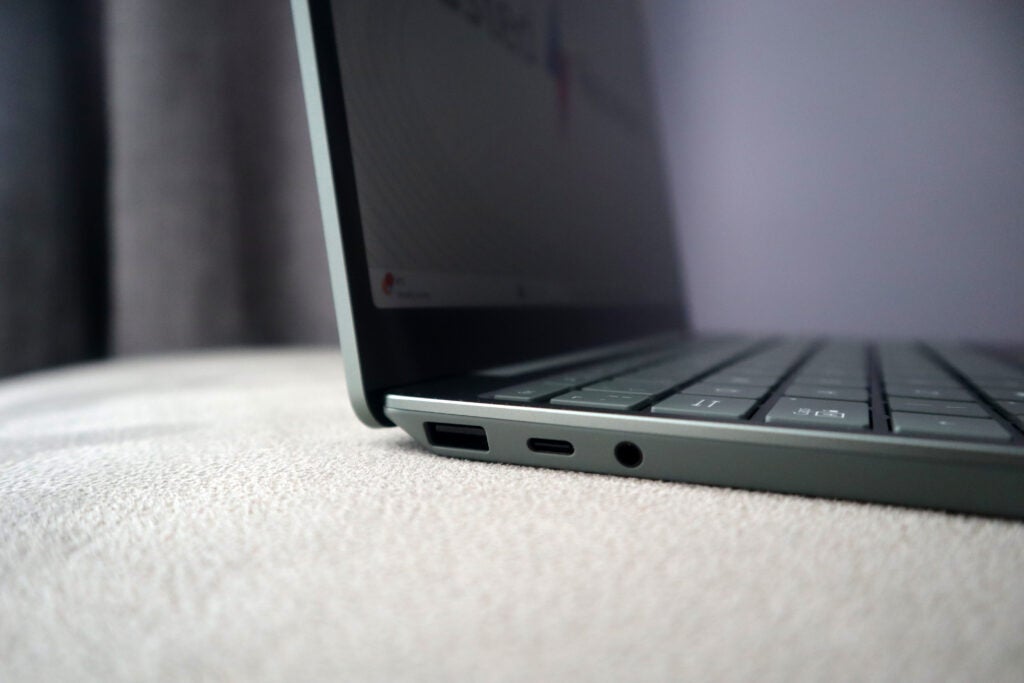
However, that slim frame has led to some major sacrifices. The port selection on the Surface Laptop Go 3 is shocking for the price. offering a singular USB-A, USB-C and headphone jack on the left-hand side, while on the right is Microsoft’s own proprietary Surface Connect port for charging on the right. That’s it. No HDMI, nor SD card reader, or anything else. It seems clear that Microsoft is intent on making users live the dongle life.
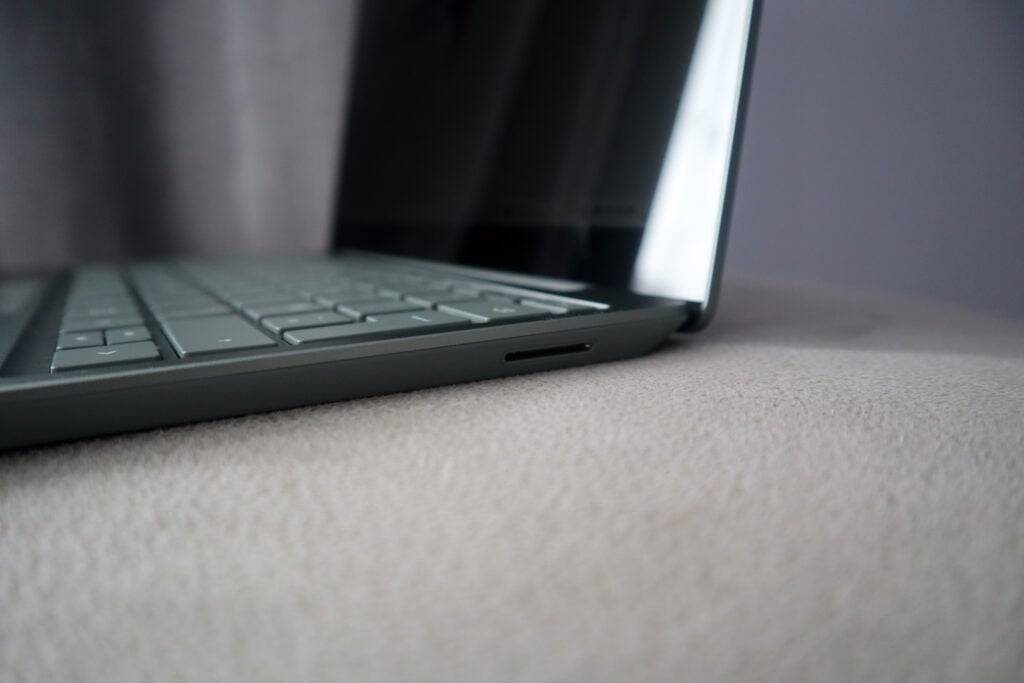
Its keyboard is especially comfortable to use, and the 65 per cent compact layout is perfectly usable for a laptop of this size. Legends are clear, and the scissor actuation is excellent for long typing sessions. It isn’t backlit though, which is a shame, so after-dark working is off the cards.
The trackpad is an okay size, and it’s tactile to use with a dampened feel, so as not to be too noisy. My only issue with it is that the plastic that has been used has the tendency to get quite greasy from finger marks, even with clean hands.
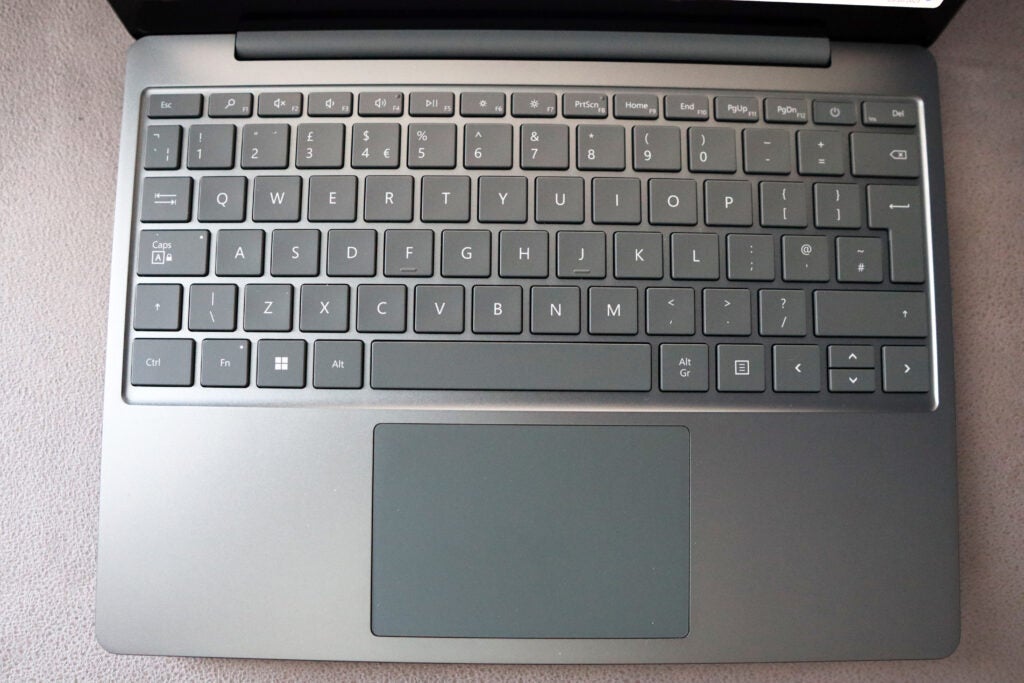
The Surface Laptop Go 3 comes in a white box and features no plastic at all in the packaging, with it being mostly made of cardboard. The accessories and cables also come in individual cardboard boxes.
Display and Sound
- Images can look grainy
- Reasonably colour-accurate and bright
- Excellent speakers
The Surface Laptop Go 3’s display isn’t necessarily what you’d expect to find on a laptop of its price. As opposed to opting for a higher-res, bigger screen display, Microsoft has opted to go for a 12.4-inch panel with a 1536 x 1024 resolution. That’s smaller than Full HD (1920 x 1080) and means that images can look grainy even on a smaller panel. That was my experience in testing both when using the Surface Laptop Go 3 for productivity tasks and for kicking back and watching Disney+ after work.
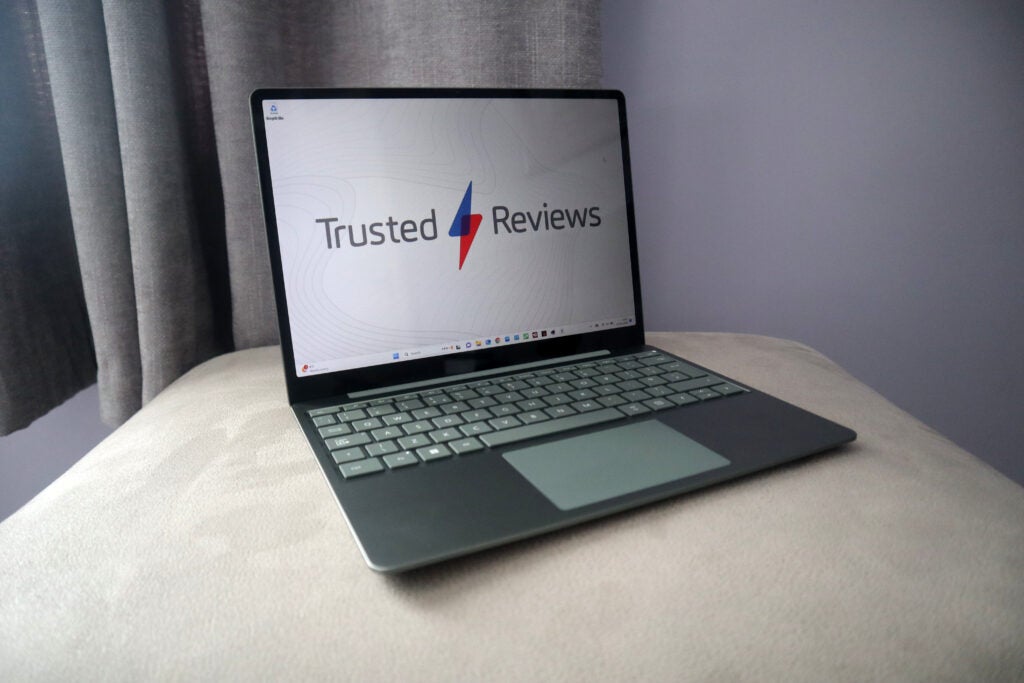
As much as images may look grainy, it is at least a reasonably colour-accurate panel with 95% coverage of the sRGB colour gamut, meaning it displays all the mainstream colours needed for day-to-day work rather well. Its measured 304.7 nits of brightness just meets our targets and means the Surface Laptop Go 3 offers decently vivid images.
On the plus side, its speakers are fantastic for a laptop of its price, offering a good body and some decent depth and extension, too. It made watching content on Disney+ more than passable, although you will want to hook up a headset or other set of speakers for a better experience. The 720p webcam is nothing to write home about but its passable for all your basic video conferencing needs.
Performance
- Last-generation Intel processor
- Reasonably powerful for productivity tasks
- Sluggish, low-capacity SSD
The odd choices continue with the Surface Laptop Go 3’s choice of processor. The Intel Core i5-1235U processor inside is nearly two generations old, on a laptop released at the back end of 2023, which seems baffling. Nonetheless, its 10 cores and 12 threads mean it isn’t underpowered by any means and remains a competent choice for what the Surface Laptop Go 3 is designed for. The 16GB of RAM provides solid headroom for more intensive workloads and multi-tasking, alongside 256GB SSD storage.
The new price of the Surface Laptop Go 3 puts it in a difficult position. The range would previously be contending with the budget laptop market but, now, its higher starting price gives it fiercer competition despite not much changing in terms of what it can offer.
It performed well in a variety of synthetic benchmark tests, including Cinebench R23 and 3D Mark Time Spy, with scores close to slightly more expensive offerings such as the Acer Swift Edge 16. However, the results posted in Geekbench 6 revealed the limits of the i5-1235U, with a score that was virtually half of the scores that laptops with 13th Gen Intel and Ryzen 7000 laptop chips featured – the Swift Edge 16’s score of just over 10,000 is a lot higher than the Surface Laptop Go 3 while running Ryzen, and it’s the same story with Samsung’s Galaxy Book 3 360 and its newer Intel Core i5-1340P.
Further, when put up against laptops in the £400-£700 bracket that it used to contend with, it either falls short or keeps pace. Those looking for a stylish student productivity laptop should now look to the likes of the HP Pavilion SE 14 and Asus Chromebook Plus CX34 to serve their performance needs.
Nonetheless, for day-to-day working and a bit of photo editing on Photoshop, the Surface Laptop Go 3 felt nippy. Opening a load of Chrome tabs didn’t cause it to falter, and multi-tasking with those open and running Spotify and Photoshop didn’t slow the Surface Laptop Go 3 down too much.
The 256GB SSD offers an okay capacity for storing files and apps. However, it isn’t the quickest option by any means with measured read and write speeds of 3297.02 MB/s and 2002.93 MB/s respectively.
Software
- Clean and slick OS with no bloatware
- Lack of AI features, unlike Microsoft’s more expensive laptops
The benefit of opting for a Microsoft Windows laptop is evident when it comes to software. There isn’t any bloatware in sight, and its Windows 11 OS is up-to-date, clean, and easy to use. It’s an OS that has grown on me as I’ve used it day-to-day in both laptop and desktop configuration and on the Surface Laptop Go 3, felt slick and responsive.
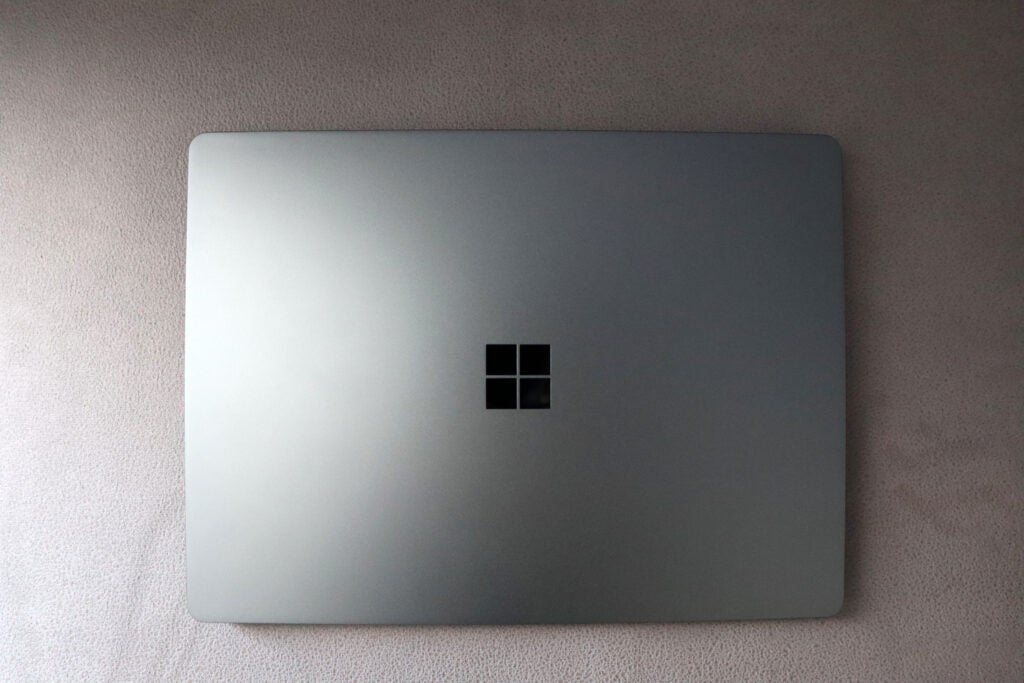
The Surface Laptop Go 3 does come with some handy apps pre-installed, such as Netflix and Spotify to get you up and running, as well as the Surface app, which is an interesting first-party app that gives you basic information about your device, including its battery percentage, serial number, and the length of time left on your warranty.
Unlike the more expensive Surface Laptop Studio 2, the Surface Laptop Go 3 misses out on Windows’ new AI webcam features, largely thanks to its 12th Gen Intel CPU lacking the extra AI chops of its big sibling. It will get Copilot with the next Windows update, although for the life of me, I couldn’t get it to work during my time with the device.
Battery Life
- Lasted for 9 hours 10 minutes in the battery test
- Capable of lasting for a working day
In dialling the brightness down to 150 nits and running the PCMark 10 battery test, the Surface Laptop Go 3 lasted for 9 hours and 10 minutes. That’s a far cry from the 15 hours that Microsoft quotes but is still reasonable enough endurance to get through a working day.
It’s beaten off by a lot of other Windows laptops at a similar price point, including those with OLED displays such as the Asus Vivobook S 15 OLED (2023), whose screen you would expect to have a larger battery draw than the LCD Microsoft is using here. Lasting for just over 9 hours will get you through a working day with a bit of hypermiling, although you may well be reaching for the charger a little earlier than you may have initially expected.
Latest deals
Should you buy it?
You want a sleek and compact chassis
Where the Surface Laptop Go 3 wins it’s with its dinky and lightweight, solid chassis. If you want an especially small laptop to take on your travels, this is one to consider.
You want a wider port selection
Arguably the biggest pitfall of the Surface Laptop Go 3 is its iffy port selection which either misses out on a lot of the basics for a laptop in 2023 or doesn’t provide enough of them.
Final Thoughts
Considering that the previous two generations of Microsoft’s Surface Laptop Go range have been home runs and regular features on our list of the best Windows laptops, I had high hopes for this third generation. However, a major price hike and too many cut corners mean this simply isn’t as good of a choice as it could and should have been.
The Sage green colour looks excellent and this is a lightweight and compact laptop that’s especially portable. It’s got a comfortable keyboard and trackpad and looks modern. What’s more, it’s reasonably powerful and offers some good endurance.
However, all of the above comes with some large caveats – the port selection is odd and minimal, while the processor powering the Surface Laptop Go 3 isn’t even part of Intel’s latest generation. The battery life is also short of the competition, while the 12.5-inch display provides a resolution short of Full HD and grainy images.
Compared to similarly priced options such as the Asus Vivobook S 15 OLED (2023) and the Samsung Galaxy Book 3 360, the Surface Laptop Go 3 is now a niche product for those who crave the signature Surface look. Those looking for devices in the category this laptop used to sit in should consider the HP Pavilion SE 14, Asus Chromebook Plus CX34 and other top budget laptops.
How we test
Every laptop we review goes through a series of uniform checks designed to gauge key things including build quality, performance, screen quality and battery life.
These include formal synthetic benchmarks and scripted tests, plus a series of real-world checks, such as how well it runs popular apps.
We used as our main laptop for at least a week.
Tested the performance via both benchmark tests and real-world use.
We tested the battery with a benchmark test and real-world use.
FAQs
Yes, the Surface Laptop Go 3 comes with Windows 11 Home, unlike previous generations which came with Windows in S mode.
Microsoft recently announced that Surface devices released after January 2021 will come with six years of firmware and driver updates.
Trusted Reviews test data
PCMark 10
Cinebench R23 multi core
Cinebench R23 single core
Geekbench 5 single core
Geekbench 5 multi core
Geekbench 6 single core
Geekbench 6 multi core
3DMark Time Spy
CrystalDiskMark Read speed
CrystalDiskMark Write Speed
Brightness (SDR)
Black level
Contrast ratio
White Visual Colour Temperature
sRGB
Adobe RGB
DCI-P3
PCMark Battery (office)
Verdict
Microsoft’s Surface Laptop Go 3 is a fall from grace. It offers reasonable performance and power in a sleek chassis but skimps out on its display and ports to offer an experience beaten by many of its competitors. Its higher starting price makes it a tough sell in both the budget and high-end productivity segments of the market.
Pros
- Stylish, lightweight construction
- Decent performance
- Great speakers
- Average battery life
Cons
- Poor port selection
- Middling display
- Lower horsepower than rivals
-
Lightweight frame:At just 1.13kg, the Surface Laptop Go 3 is especially light, and a rather portable laptop for those on the go. -
12th Gen Intel Core processor:There’s also a 10-core and 12-thread Intel Core i5-1235U processor to offer decent power. -
Smaller 12.5-inch display:The Surface Laptop Go 3 also provides a smaller 12.5-inch display for those after a more compact screen
Introduction
As the old saying goes, if you want something done properly, do it yourself. With the release of Microsoft’s Surface Laptop Go 3, it represents a brand-new Windows laptop from the very makers of the operating system.
In the past, the Surface Laptop Go line has served up some of the best Windows laptops but the omission of cheaper options this time out gives it a steeper hill to climb. Now, it comes as quite an expensive laptop for its mid-range status, with my review configuration running costing £999 but, for those after a stylish laptop with reasonable performance, it could still be worth it.
I’ve had the latest Surface Laptop Go in for testing for the last few weeks, and here are my thoughts.
Design and Keyboard
- Stylish and modern looks
- Bewilderingly terrible port selection
- Comfortable keyboard, although not backlit
As with the previous generations, the Surface Laptop Go 3 is a stylish-looking laptop and makes for one of the better-looking mid-range Windows laptops within its price range. The configuration I’ve got here comes in what Microsoft calls ‘Sage’, which is a metallic green colour. It is also available in more conventional colours, such as ‘Platinum’ and ‘Ice Blue’, too, if you want something a little more standard.
It is a positively dinky machine when pitted against my 16-inch MacBook Pro, especially given its small 12-inch screen. At just 15.7mm thick, it is also a slender laptop and is easy to sling into a bag. What’s more, a mass of just 1.13kg makes it one of the most portable laptops I’ve ever tested, and it certainly won’t take up too much space in a bag. It’s also comprised of a variety of materials, with an anodized aluminium lid, and a bottom half made of aluminium and polycarbonate composite resin which features 30% post-consumer recycled content – that’s a nice touch and wins Microsoft some points for sustainability.

However, that slim frame has led to some major sacrifices. The port selection on the Surface Laptop Go 3 is shocking for the price. offering a singular USB-A, USB-C and headphone jack on the left-hand side, while on the right is Microsoft’s own proprietary Surface Connect port for charging on the right. That’s it. No HDMI, nor SD card reader, or anything else. It seems clear that Microsoft is intent on making users live the dongle life.

Its keyboard is especially comfortable to use, and the 65 per cent compact layout is perfectly usable for a laptop of this size. Legends are clear, and the scissor actuation is excellent for long typing sessions. It isn’t backlit though, which is a shame, so after-dark working is off the cards.
The trackpad is an okay size, and it’s tactile to use with a dampened feel, so as not to be too noisy. My only issue with it is that the plastic that has been used has the tendency to get quite greasy from finger marks, even with clean hands.

The Surface Laptop Go 3 comes in a white box and features no plastic at all in the packaging, with it being mostly made of cardboard. The accessories and cables also come in individual cardboard boxes.
Display and Sound
- Images can look grainy
- Reasonably colour-accurate and bright
- Excellent speakers
The Surface Laptop Go 3’s display isn’t necessarily what you’d expect to find on a laptop of its price. As opposed to opting for a higher-res, bigger screen display, Microsoft has opted to go for a 12.4-inch panel with a 1536 x 1024 resolution. That’s smaller than Full HD (1920 x 1080) and means that images can look grainy even on a smaller panel. That was my experience in testing both when using the Surface Laptop Go 3 for productivity tasks and for kicking back and watching Disney+ after work.

As much as images may look grainy, it is at least a reasonably colour-accurate panel with 95% coverage of the sRGB colour gamut, meaning it displays all the mainstream colours needed for day-to-day work rather well. Its measured 304.7 nits of brightness just meets our targets and means the Surface Laptop Go 3 offers decently vivid images.
On the plus side, its speakers are fantastic for a laptop of its price, offering a good body and some decent depth and extension, too. It made watching content on Disney+ more than passable, although you will want to hook up a headset or other set of speakers for a better experience. The 720p webcam is nothing to write home about but its passable for all your basic video conferencing needs.
Performance
- Last-generation Intel processor
- Reasonably powerful for productivity tasks
- Sluggish, low-capacity SSD
The odd choices continue with the Surface Laptop Go 3’s choice of processor. The Intel Core i5-1235U processor inside is nearly two generations old, on a laptop released at the back end of 2023, which seems baffling. Nonetheless, its 10 cores and 12 threads mean it isn’t underpowered by any means and remains a competent choice for what the Surface Laptop Go 3 is designed for. The 16GB of RAM provides solid headroom for more intensive workloads and multi-tasking, alongside 256GB SSD storage.
The new price of the Surface Laptop Go 3 puts it in a difficult position. The range would previously be contending with the budget laptop market but, now, its higher starting price gives it fiercer competition despite not much changing in terms of what it can offer.
It performed well in a variety of synthetic benchmark tests, including Cinebench R23 and 3D Mark Time Spy, with scores close to slightly more expensive offerings such as the Acer Swift Edge 16. However, the results posted in Geekbench 6 revealed the limits of the i5-1235U, with a score that was virtually half of the scores that laptops with 13th Gen Intel and Ryzen 7000 laptop chips featured – the Swift Edge 16’s score of just over 10,000 is a lot higher than the Surface Laptop Go 3 while running Ryzen, and it’s the same story with Samsung’s Galaxy Book 3 360 and its newer Intel Core i5-1340P.
Further, when put up against laptops in the £400-£700 bracket that it used to contend with, it either falls short or keeps pace. Those looking for a stylish student productivity laptop should now look to the likes of the HP Pavilion SE 14 and Asus Chromebook Plus CX34 to serve their performance needs.
Nonetheless, for day-to-day working and a bit of photo editing on Photoshop, the Surface Laptop Go 3 felt nippy. Opening a load of Chrome tabs didn’t cause it to falter, and multi-tasking with those open and running Spotify and Photoshop didn’t slow the Surface Laptop Go 3 down too much.
The 256GB SSD offers an okay capacity for storing files and apps. However, it isn’t the quickest option by any means with measured read and write speeds of 3297.02 MB/s and 2002.93 MB/s respectively.
Software
- Clean and slick OS with no bloatware
- Lack of AI features, unlike Microsoft’s more expensive laptops
The benefit of opting for a Microsoft Windows laptop is evident when it comes to software. There isn’t any bloatware in sight, and its Windows 11 OS is up-to-date, clean, and easy to use. It’s an OS that has grown on me as I’ve used it day-to-day in both laptop and desktop configuration and on the Surface Laptop Go 3, felt slick and responsive.

The Surface Laptop Go 3 does come with some handy apps pre-installed, such as Netflix and Spotify to get you up and running, as well as the Surface app, which is an interesting first-party app that gives you basic information about your device, including its battery percentage, serial number, and the length of time left on your warranty.
Unlike the more expensive Surface Laptop Studio 2, the Surface Laptop Go 3 misses out on Windows’ new AI webcam features, largely thanks to its 12th Gen Intel CPU lacking the extra AI chops of its big sibling. It will get Copilot with the next Windows update, although for the life of me, I couldn’t get it to work during my time with the device.
Battery Life
- Lasted for 9 hours 10 minutes in the battery test
- Capable of lasting for a working day
In dialling the brightness down to 150 nits and running the PCMark 10 battery test, the Surface Laptop Go 3 lasted for 9 hours and 10 minutes. That’s a far cry from the 15 hours that Microsoft quotes but is still reasonable enough endurance to get through a working day.
It’s beaten off by a lot of other Windows laptops at a similar price point, including those with OLED displays such as the Asus Vivobook S 15 OLED (2023), whose screen you would expect to have a larger battery draw than the LCD Microsoft is using here. Lasting for just over 9 hours will get you through a working day with a bit of hypermiling, although you may well be reaching for the charger a little earlier than you may have initially expected.
Latest deals
Should you buy it?
You want a sleek and compact chassis
Where the Surface Laptop Go 3 wins it’s with its dinky and lightweight, solid chassis. If you want an especially small laptop to take on your travels, this is one to consider.
You want a wider port selection
Arguably the biggest pitfall of the Surface Laptop Go 3 is its iffy port selection which either misses out on a lot of the basics for a laptop in 2023 or doesn’t provide enough of them.
Final Thoughts
Considering that the previous two generations of Microsoft’s Surface Laptop Go range have been home runs and regular features on our list of the best Windows laptops, I had high hopes for this third generation. However, a major price hike and too many cut corners mean this simply isn’t as good of a choice as it could and should have been.
The Sage green colour looks excellent and this is a lightweight and compact laptop that’s especially portable. It’s got a comfortable keyboard and trackpad and looks modern. What’s more, it’s reasonably powerful and offers some good endurance.
However, all of the above comes with some large caveats – the port selection is odd and minimal, while the processor powering the Surface Laptop Go 3 isn’t even part of Intel’s latest generation. The battery life is also short of the competition, while the 12.5-inch display provides a resolution short of Full HD and grainy images.
Compared to similarly priced options such as the Asus Vivobook S 15 OLED (2023) and the Samsung Galaxy Book 3 360, the Surface Laptop Go 3 is now a niche product for those who crave the signature Surface look. Those looking for devices in the category this laptop used to sit in should consider the HP Pavilion SE 14, Asus Chromebook Plus CX34 and other top budget laptops.
How we test
Every laptop we review goes through a series of uniform checks designed to gauge key things including build quality, performance, screen quality and battery life.
These include formal synthetic benchmarks and scripted tests, plus a series of real-world checks, such as how well it runs popular apps.
We used as our main laptop for at least a week.
Tested the performance via both benchmark tests and real-world use.
We tested the battery with a benchmark test and real-world use.
FAQs
Yes, the Surface Laptop Go 3 comes with Windows 11 Home, unlike previous generations which came with Windows in S mode.
Microsoft recently announced that Surface devices released after January 2021 will come with six years of firmware and driver updates.
Trusted Reviews test data
PCMark 10
Cinebench R23 multi core
Cinebench R23 single core
Geekbench 5 single core
Geekbench 5 multi core
Geekbench 6 single core
Geekbench 6 multi core
3DMark Time Spy
CrystalDiskMark Read speed
CrystalDiskMark Write Speed
Brightness (SDR)
Black level
Contrast ratio
White Visual Colour Temperature
sRGB
Adobe RGB
DCI-P3
PCMark Battery (office)
























